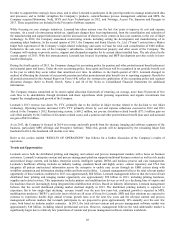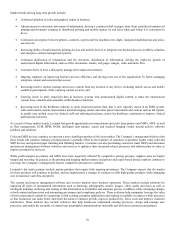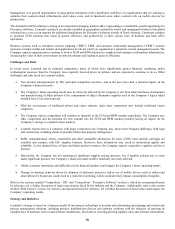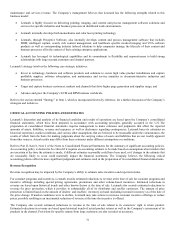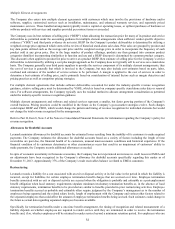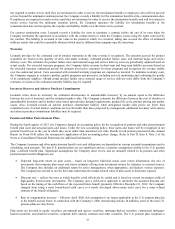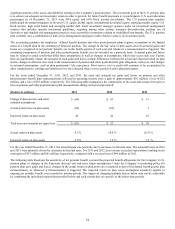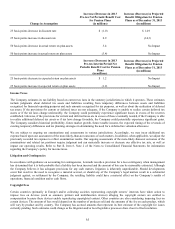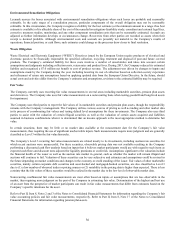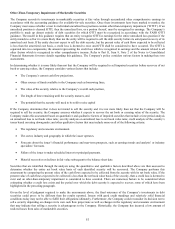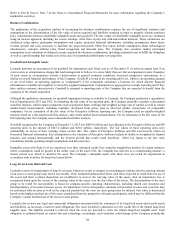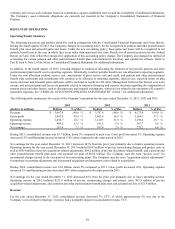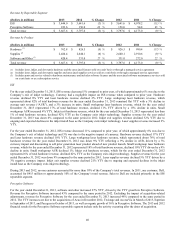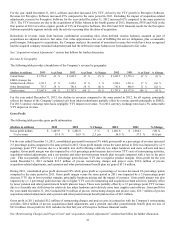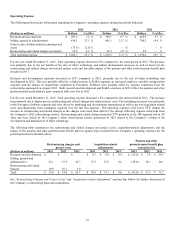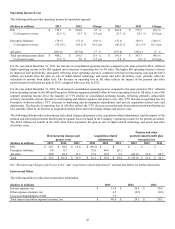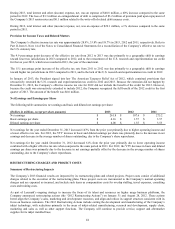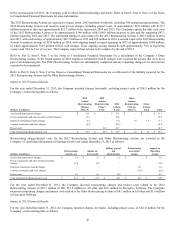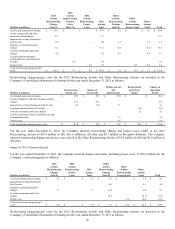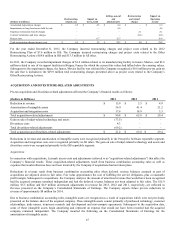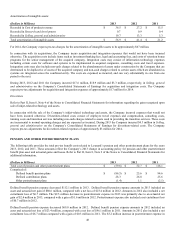Lexmark 2013 Annual Report Download - page 42
Download and view the complete annual report
Please find page 42 of the 2013 Lexmark annual report below. You can navigate through the pages in the report by either clicking on the pages listed below, or by using the keyword search tool below to find specific information within the annual report.
38
Refer to Part II, Item 8, Note 7 of the Notes to Consolidated Financial Statements for more information regarding the Company’s
marketable securities.
Business Combinations
The application of the acquisition method of accounting for business combinations requires the use of significant estimates and
assumptions in the determination of the fair value of assets acquired and liabilities assumed in order to properly allocate purchase
price consideration between identifiable intangible assets and goodwill. The fair values of identifiable intangible assets are estimated
using an income approach, including the excess earnings, relief from royalty and with-and-without methods. These estimations are
conducted using market participant assumptions and require projected financial information, including assumptions about future
revenue growth and costs necessary to facilitate the projected growth. Other key inputs include assumptions about technological
obsolescence, customer attrition rates, brand recognition and discount rates. The Company also considers market participant
assumptions in its valuations of deferred revenue acquired in a business combination, including estimated costs to fulfill the obligation
as well as a profit markup that would exist in the case of a hypothetical third-party servicing firm.
Goodwill and Intangible Assets
Lexmark performs an assessment of its goodwill for impairment each fiscal year as of December 31 or between annual tests if an
event occurs or circumstances change that lead management to believe it is more likely than not that an impairment exists. Examples
of such events or circumstances include a deterioration in general economic conditions, increased competitive environment, or a
decline in overall financial performance of the Company. Goodwill is tested at the reporting unit level, which is an operating segment
or one level below an operating segment (a "component") if the component constitutes a business for which discrete financial
information is available and regularly reviewed by segment management. Components are aggregated as a single reporting unit if they
have similar economic characteristics. Goodwill is assigned to reporting units of the Company that are expected to benefit from the
synergies of the related acquisition.
Although the qualitative assessment for goodwill impairment testing is available to Lexmark, the Company performed a quantitative
test of impairment in 2013 and 2012. In estimating the fair value of its reporting units, the Company generally considers a discounted
cash flow analysis, which requires judgments such as projected future earnings and weighted average cost of capital, as well as certain
market-based measurements, including multiples developed from prices paid in observed market transactions of comparable
companies. For its estimation of the fair value of the Perceptive Software reporting unit, the Company used an equally-weighted
measure based on a discounted cash flow analysis and certain market-based measurements. For its estimation of the fair value of the
ISS reporting unit, the Company used a discounted cash flow analysis.
Goodwill recognized by the Company at December 31, 2013 was $456.0 million and was allocated to the Perceptive Software and ISS
reporting units in the amount of $435.2 million and $20.8 million, respectively. The fair values of these reporting units were
substantially in excess of their carrying values on this date. The values of Perceptive Software and ISS were heavily reliant on
forecasted financial information. Key assumptions to the valuation of Perceptive Software include its ability to strengthen its channel
presence and expand internationally and the revenue growth that would result therefrom. Other key inputs to the fair value
calculations include operating margin assumptions and discount rates.
Intangible assets with finite lives are amortized over their estimated useful lives using the straight-line method. In certain instances
where consumption could be greater in the earlier years of the asset’s life, the Company has selected, as a compensating measure, a
shorter period over which to amortize the asset. The Company’s intangible assets with finite lives are tested for impairment in
accordance with its policy for long-lived assets below.
Long-Lived Assets Held and Used
Lexmark reviews for impairment of long-lived assets whenever events or changes in circumstances indicate that the carrying amount
of an asset (or asset group) may not be recoverable. If the estimated undiscounted future cash flows expected to result from the use of
the assets and their eventual disposition are insufficient to recover the carrying value of the assets, then an impairment loss is
recognized based upon the excess of the carrying value of the assets over the fair value of the assets. The determination of the asset
group to be tested for recoverability is based on company-specific operating characteristics, including shared cost structures and
interdependency of revenues between assets. An impairment review incorporates estimates of forecasted revenue and costs that may
be associated with an asset as well as the expected periods that the asset (or asset group) may be utilized. Fair value is determined
based on the highest and best use of the assets considered from the perspective of market participants, which may be different than the
Company’s actual intended use of the asset (or asset group).
Lexmark also reviews any legal and contractual obligations associated with the retirement of its long-lived assets and records assets
and liabilities, as necessary, related to such obligations. The asset recorded is amortized over the useful life of the related long-lived
tangible asset. The liability recorded is relieved when the costs are incurred to retire the related long-lived tangible asset. Each
obligation is estimated based on current law and technology; accordingly, such estimates could change as the Company periodically
38


